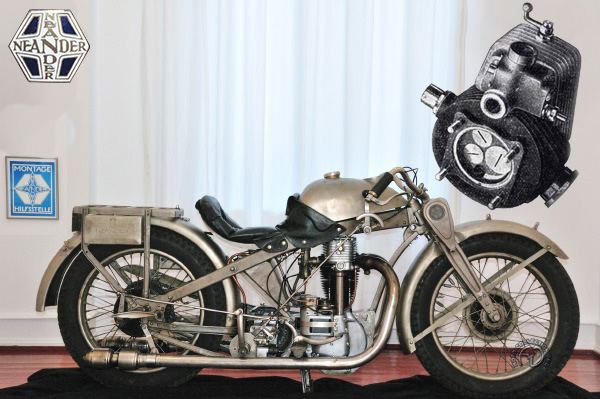
Photo ou archives : F-M. Dumas
7504
NEANDER
1000 BRD - 1929
The innovative non-conformist
Ernst Neumann-Neander built his first bikes in 1924 while working with Allright, then set out on his own in 1925. His creations quickly distinguished themselves for their originality. The Neander 122cc ┬ľ and subsequently 175cc ┬ľ machines with Villiers two-stroke engines enjoyed great sports success ridden by Gohr and Goretzki. In 1927, Neander standardized its unconventional cycle parts ┬ľ a smaller version in aluminum for its 122 and 175cc bikes and a larger pressed-steel development of the original design for the 250-1000cc models, with 347 and 437cc K├╝chen ohc engines, JAP singles and twins or MAG 500 and 996cc power units.
Twin-Beam Construction
The Neander frame was mostly composed of two beams, bolted at the front to the steering head and linked by the rear spindle. The pressed-steel version was cadmium-plated.
Unusual Front Forks
The unusual front forks pivoted fore and aft, controlled by a battery of small leaf springs contained in egg-shaped casings on either side of the steering head, which incorporated a steering damper. The leaf-sprung "anatomical" saddle was mounted low behind the gas tank and incorporated a glove compartment in its rear portion. The always minimal production of the Neander stopped in 1929, but Opel had bought the license to build the design in its Elite-Diamant works in 1928 and fitted the frames with its own single-cylinder engines. After General Motors absorbed Opel in 1930, the final six Neanders were built under the EO (Elite-Opel) name with a three-valve K├╝chen sohc engine; in 1929 Neumann-Neander had turned his highly original attention to the car.
SPECIFICATIONS
Engine: 996cc air-cooled MAG V-twin four-stroke
Power Rating: 40 hp
Valves: overhead intake, side exhaust
Fuel System: single carburetor
Transmission: 3-speed tank-shift, chain final drive
Suspension: pressed-steel leaf-sprung swing arm (front); rigid (rear)
Brakes: drum (front & rear)
Wheels: wire (front & rear)
Maximum Speed: 87 mph
The pressed-steel frames of the larger Neanders were brightly cadmium-plated and looked like aluminum. This 1000 BRD (main photo) has lost its original leaf-sprung front fork (inset).